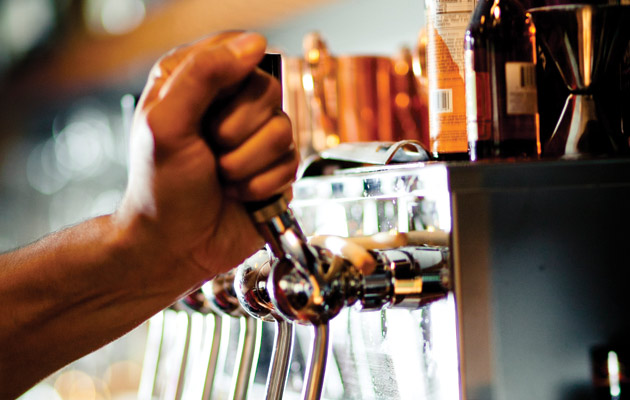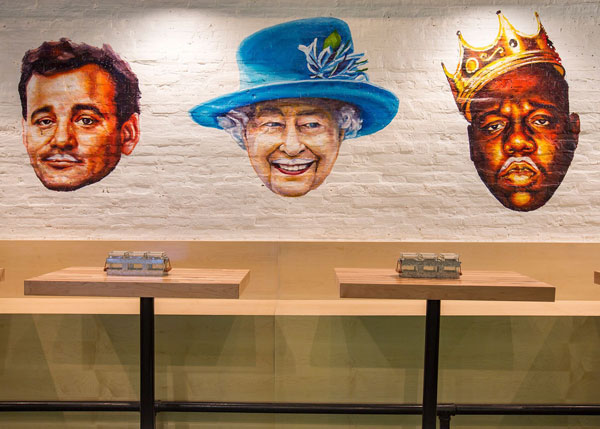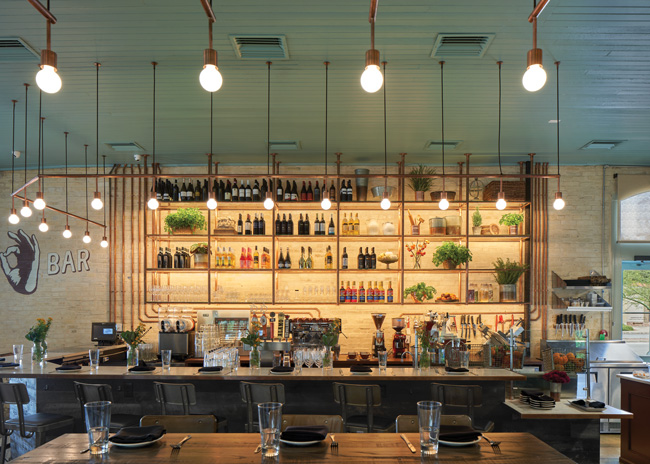It's time to tap into one of the hottest restaurant trends. Thanks to the craft beer movement, many restaurants have upped their brew selections to scores of handles. The real revolution, however, is tapping into all sorts of beverages: kegged wines, spirits, cocktails, kombucha, sake and more.
For some tap pioneers, draft service represents an integral part of their concepts; the systems are key visual design elements. While still largely in the experimental stage, this draft rush brings designers together with restaurateurs to collaborate and come up with inventive ways to dispense a variety of beverages, each with its own advantages and challenges.
What's fueling the trend? A confluence of factors, including operational speed and efficiency, lower carbon footprint, increased consumer interest and acceptance, and improved quality and availability of systems and product.
"We are seeing a big trend toward more draft taps in restaurants," says Greg Neblock, program director for the interdisciplinary design firm Interplan LLC. One of his clients, for example, boasts 32 beers on draft; another offers wine from a fancy stainless steel tower with 8 taps. With the growth of these tap concepts, designers have to get involved with draft equipment vendors and suppliers to coordinate and integrate those systems into the designs.
As the Tap Turns
"Initially, the novelty of draft beverages drew us. When the novelty wears off, there are the practical aspects that appeal," says Nick Jarvis, bar manager at TanakaSan, a modern American Asian restaurant in Seattle. The recently opened restaurant is the most tap-centric of the Tom Douglas restaurant group's concepts, with 10 draft beers, 2 wines on tap, 3 kegged cocktails and house-made soda and cold-brew coffee on tap.
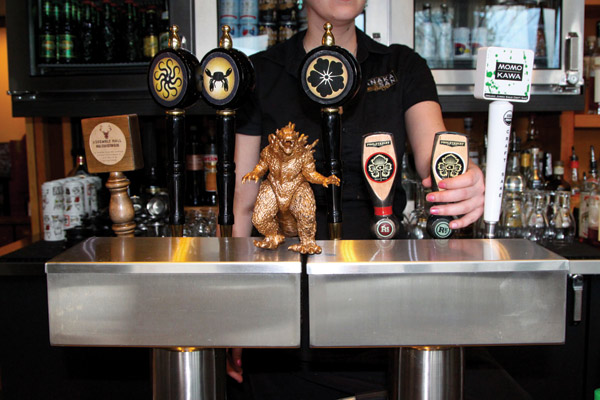
When an American producer recently made its sake available in keg form, TanakaSan eagerly added that to its tap lineup. "Our idea with draft beverages was to have creative options easily accessible at the turn of a tap, having cool cocktails without bartenders doing all that muddling and shaking," says Jarvis.
"We have a lot of draft systems in our properties for beer, but more exciting are the tap systems for wine, cocktails and kombucha," says Emily Wines, MS, senior director of national beverage programs for San Francisco-based Kimpton Hotels and Restaurants. Blue Hound Kitchen & Cocktails in Phoenix, for example, boasts 16 wines on draft. "I like that the wine coming out of kegs is fresh from the first glass to the very last," says Wines.
Kimpton embraces the concept of tap beverages for a variety of reasons. For example, because bartenders can simply turn a tap and don't have to open bottle after bottle, these systems can improve speed of service. And refillable kegs represent a greener alternative to recycling wine bottles.
On the Drafting Table
"When I got into the design of Two Urban Licks 10 years ago, the question was, what can we do that would be unique and coincide with the fact we put the kitchen in the middle of a 10,000-square-foot restaurant?" recalls Todd Rushing, a partner in Concentrics Restaurants, an Atlanta-based company operating some 30 concepts. The answer was to build a 26-foot steel tower that now holds and dispenses 72 kegs of wine in an elaborate system of cradles and tubing — among the first of its kind in the U.S. Another Concentrics' operation, the gastropub Tap, sports a similar though smaller setup.
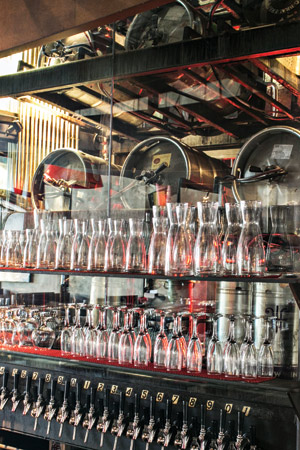 Chad Munsey, managing partner and sommelier at Ovinté, a full-service restaurant and wine bar in Jacksonville, Fla., says, "We opened the restaurant with the thought that it would be wine-driven, so these dispensers are one more element of the concept." The design of the Wine Library room features a self-serve dispenser where guests can tap 1-, 2- or 4-ounce tastes of the 24 wines offered.
Chad Munsey, managing partner and sommelier at Ovinté, a full-service restaurant and wine bar in Jacksonville, Fla., says, "We opened the restaurant with the thought that it would be wine-driven, so these dispensers are one more element of the concept." The design of the Wine Library room features a self-serve dispenser where guests can tap 1-, 2- or 4-ounce tastes of the 24 wines offered.
The Italian-made bottled wine machine was built into a handsome wooden cabinet, which allows for data wiring and storage below as well as a display of crystal decanters above. The system is activated by guests accessing a magnetic/RFID card reader with a debit card; each wine has its own price and information screen and three buttons for the pours. Nitrogen keeps wine in the bottles good for about three weeks; but they change out more frequently than that, says Munsey. Although the bar pours more than 50 wines by the glass, the sommelier says the tap setup is a good way for guests to explore Ovinté's extensive bottle selection.
Get a Handle on It
For the two specialty cocktails on tap at TC4 & Co.'s new restaurant The League Kitchen & Tavern, Brandon Turner, the company's corporate mixologist, worked with its vodka and gin suppliers to design a custom handle for each drink. The restaurant, which opened last November in Austin, Texas, converted 2 of the existing 24 beer taps for the drinks: the Texas Mule, a variation on the Moscow Mule made with serrano-spiked vodka, and a gin-based version of a Paloma. Turner mixes five-gallon batches of the cocktails and puts them in Cornelius kegs, which he runs with CO2, nitrogen or a mix of both to get the desired level of carbonation. "It works well for us in terms of cost, speed and efficiency," Turner says.
"Those cartoonish marketing handles that beer producers supply are good at attracting customer attention, especially in sports bars," says designer Neblock. However, that approach doesn't work at higher-end specialty restaurants, which tend toward a uniform design of smaller, more sophisticated tap handles.
Tap and Two Urban Licks use modest stainless steel taps with black grips. "We didn't go with fancy taps because we wanted a clean, symmetrical look," comments Rushing.
TanakaSan combines both strategies. On the back bar, beer taps sport producers' fancy handles. On the front bar, taps for the other beverages match the restaurant's color scheme of black and gold and are adorned with the TanakaSan logo. "The taps make a graphic visual statement," says Jarvis.
Trial and Error
Although existing technology and systems work well for draft beer, other beverages require adjustments, with many operators taking an experimental approach.
"In the beginning, offering tap wine was challenging because there weren't a lot of options," recalls Wines. "You can't just take beer taps and retrofit them because there's so much acid in wine."
For wine systems, she specifies all stainless-steel fittings and surgical grade tubing. "And you can't switch back and forth, running red wine then white, because you'll end up with rosé." Wines notes that the industry has grown by leaps and bounds in the past couple of years; both the quality of the wine packaged for tap applications and the technology continue to improve.
That's true not just for wine either. At Jasper's in San Francisco, a kegged Negroni is available on tap. Another Kimpton restaurant serves Chartreuse on tap. "It can be a little gimmicky but works well if it's a cocktail that you sell a lot of," comments Wines. "Taps are great for speed, and the concept says we take this cocktail seriously."
A number of Kimpton properties use kegerators, self-contained refrigeration/tap units, to provide beverage service poolside and on patios. Now the Kimpton team is experimenting with kombucha on tap. The property brews its own fermented tea and kegs it. "Kombucha is tricky because there are solids and because it is a living thing which keeps changing," reports Wines. The solution was to work with smaller batches and a shorter timeframe.
TanakaSan has also had to experiment, for example with tapping cold-brew coffee. "There was a lot of trial and error with the cold-brew coffee because it uses nitrogen instead of the CO2 used with beer, and it was kegged using a different hookup than beer kegs," relates Jarvis. The restaurant called in a local expert for the initial installation of the draft systems.
The setup at Two Urban Licks required a reworking of the kegs themselves. "We didn't stack the wine kegs on the end like beer kegs, because we knew we'd eventually run out of space," recalls Rushing. "We put the kegs in cradles on their sides at an angle, which allowed us to get this visual we were looking for."
Because of the angle, the kegs had to be customized with a flexible hose replacing the rigid internal stem so it would draw liquid from the lowest point of the sideways keg. "I worked with my draft guy, with whom I did beer projects, on all these issues with wine so that we could come up with a successful way of serving the product," explains Rushing. "That was a little more challenging 10 years ago than it is today."
Drawing the Line
Draft systems involve running lots of lines, tubing carrying the beer, wine or other beverages out to the taps as well as other hoses that pump CO2, nitrogen, argon and other gases into the kegs for propellant and protection.
"Operators should keep keg coolers close to the bar, so they don't have long line runs," advises Neblock. "From a design standpoint, the shorter the lines to dispensing, the better."
"We found that shorter tap lines worked better with wine," concurs Wines, because the product can oxidize during a long trip from a cooler in the basement. "It's best to put those kegs directly under the bar where the draw is."
In the lounge adjacent to the Wine Library, Ovinté offers four beers on tap at the bar. The system is a direct draft from a refrigerated case below the bar, propelled with nitrogen and CO2. "We didn't want to get into a more complicated system," explains Munsey.

At The League Kitchen & Tavern, the taps are mounted on the back bar wall, with the kegs just on the other side. "That way we didn't need a glycol cooling system for the lines," notes Turner.
The keg fridge at TanakaSan nestles just inside the end of the bar, so the tap lines are short, reports Jarvis. The CO2 line runs from a nearby tank that also supplies the bar's soda gun, and a nitrogen tank is positioned next to that.
Hide or Flaunt It
When longer runs can't be avoided, designers have to deal with the spaghetti of tubing snaking throughout the restaurant or bar setting. Often the lines have to be augmented with glycol refrigerant to keep the product cold and fresh on its way to the taps.
"There are two schools of thought about running tap lines," comments Neblock. One approach is to hide the lines, run them above dropped ceilings or cloak them inside chases. The other strategy is to expose the tubing as a feature of an industrial-type design, and even paint them with an accent color.
"We like to hide all the draft lines," says Wines. She thinks exposed tubing is just another area that will collect dust and grime. "Over the long term, it doesn't look so cool," says the sommelier.
"One challenge when constructing the keg tower at Two Urban Licks was how to deal with all the different various tubing," says Rushing. Each keg has two sets of tubing: the tube out that runs down to the taps and a line in that feeds the inert gases to protect the wine from oxidation. Originally there was a single gas system, but a backflow valve faulted, which sent red wine to white wine kegs and turned it pink; now the setup uses two gas lines. Electrical conduits, which run along the inside frames of the steel structure, corral all of this tubing. "That gives it the same neat and clean look we were trying to accomplish with the rest of the restaurant," says Rushing.
What's Next on Tap?
Pioneers in applying next-gen draft technology, these companies are already looking ahead to the possibility of adding more beverages on tap. At TC4 & Co., for example, Turner wants to take over another beer tap at The League to add another cocktail. Additionally, the company is considering a new restaurant that will focus mainly on draft cocktails.
As Munsey begins work on developing other restaurant concepts beyond Ovinté, he looks to offer kegged wine on tap. And at Kimpton, the concept of tabletop taps intrigues Wines. "It's on my checklist to explore," she promises.
Rushing is playing with carbonating kegged product to make sparkling wines. "It's challenging," he admits. A new project at the Hartsfield-Jackson Airport will offer all wine and beer on tap. And a Concentrics restaurant under development in Louisville will feature not only draft wine but possibly draft cocktails too. "I'd love to try a cocktail on tap," he says.
"We're big enthusiasts of all things on tap," Jarvis says enthusiastically. Other Tom Douglas restaurants are embracing the draft: the Brave Horse Tavern is now offering its house-made ginger beer on tap, for example. Says the bar manager, "Taps are not necessarily the whole future of bar programs, but they are a very cool part."

